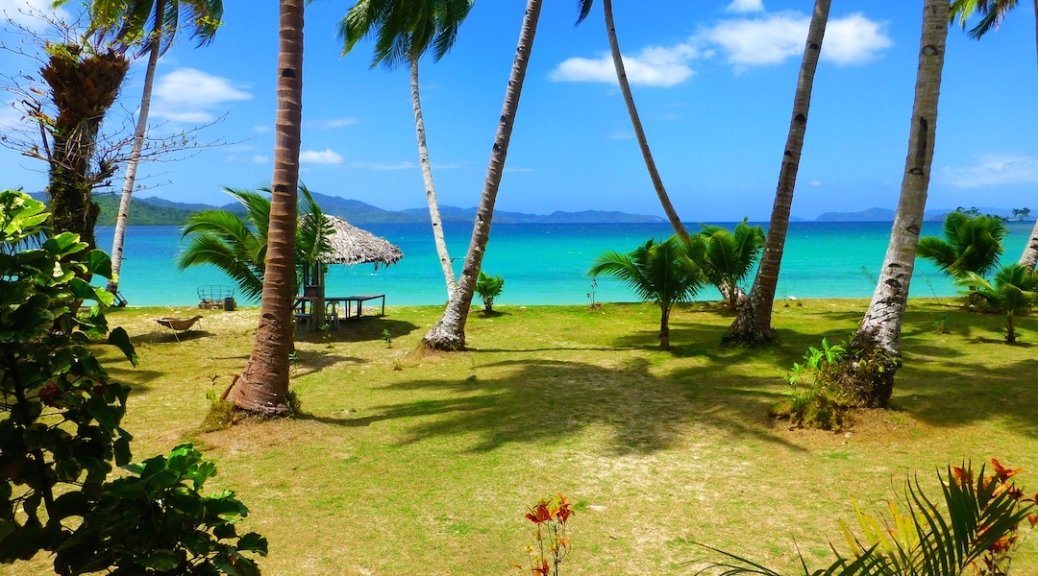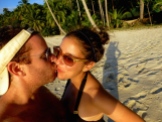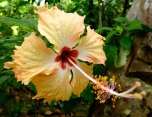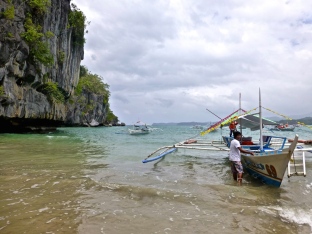If there is one place we’ve seen in all of Asia (so far) that we’d urge you to get your butts out to, and fast, it would be Coron. The beauty here is unparalleled (I mean, just stop reading here. Really. The pictures speak for themselves). And we got the feeling that it’s on the cusp of turning in the direction of more developed El Nido. Of all the places we visited in the Philippines, Coron was the most affected by Typhoon Yolanda, and perhaps it felt more deserted because of this. Or perhaps Coron is always less crowded, but either way it was much more pleasant from the tourist’s perspective. And we did not see any evidence of the damage impacting a visitor’s experience. Our boat tour guide accommodated us with an earlier start time so that we were the first to arrive at the beautiful Kayangan Lake, giving us private access to one of the most stunning places we’d ever seen. Even as the tour groups began catching up, it was never the sort of waiting in line we saw in El Nido.
We stayed at Balinsasayaw Resort, and it seemed to have unrivaled access to the highlights of Coron. The resort is on Uson Island directly across from Coron Island, with a beautiful view of the stunning black (but really gray) limestone rock formations and a short five to ten minute bangka ride to the highlights of the biggest tourist attraction of the area. In fact, where most tours were cooking lunch on the boats while the tourists checked out their first destination, we were able to visit three, stop back at our resort to pick up our freshly cooked lunch, and enjoy it in one of the small floating huts atop the house reef as an added bonus to our already fantastic day tour. Balinsasayaw’s house reef, by the way, is superb. The fish are plentiful and diverse, as are the coral and the magnificent giant clams.
Swimming in the brackish water lakes on Coron Island was sublime. The water is so clear, and so still, it’s like snorkeling in the calmest ocean you can imagine. And the rock formations along the side of the lake are just unreal. They are so deep, and the visibility so good, that it engaged my fear of heights just floating above these. To have a fear of heights and the feeling of no gravity was one of the strangest sensations I’ve ever experienced. It felt like rock climbing without the risk. These aren’t corals, but limestone rocks, so you can grab onto them and climb as you swim around them. Hell, I even jumped off of one of them. It looks like an underwater castle (the inspiration for the little mermaid’s underwater castle?) or even a bit like the South Dakota Badlands if they were submerged. The fish are not nearly as diverse as those you’d find in the open ocean, but there are still plenty, including diminutive needle nose fish that swim at the surface and are so unaffected by your presence that they’ll practically touch your mask, and a plethora of catfish in Barracuda Lake. The eponymous fish are also present there at greater depths and it is a popular dive site, though we didn’t see any barracudas from our surface position. A few other inhabitants intrigued us, but none so much as the shrimp in Kayangan Lake that had a strong affinity for Alan’s feet, hanging on and tickling him at nearly every stop.
We next visited the Twin Lagoons, which are also brackish, and the mixing of salt and fresh water was made visible by the thermocline, which caused the water along the surface to blur like it was oily. In here we saw a large and terrifying jellyfish that was brown and yellowish, which our guide stealthily spotted and disturbed from his slumber on the rocks to prod him out for our viewing pleasure.
The Coron area islands are famous for wreck diving as there are a number of sunken Japanese ships from World War II. One, Skeleton Wreck, is shallow enough for snorkelers to view, and it’s so old that it’s now almost entirely covered in coral. While this area was more crowded, it was still far less so than most destinations we visited in El Nido (maybe there were 20 other people around).
We also stopped by the small Banol Beach, again with the most unreal beautiful turquoise waters and limestone rocks, and lastly we visited a natural saltwater hot spring (called Makinit) believed to be caused by a dormant volcano, and which lies at the edge of a mangrove and the ocean. The water was around 101 Fahrenheit, which is quite warm for a day in the hot sun, but it was surprisingly nice (for a few minutes).
One morning Alan did two dives. The first was at CYC Beach/Reef where a few other boats were present, and the diving was good though not great. The second was at Twin Peaks Reef and this was more of a proper wall dive and with nobody present except me, the company diver and our boat man who decided to join us. The coral was great and the fish were very good, with huge numbers of smaller guys. I was a little sad not to visit any of the famous wrecks, but it was my fault for not being more pro-active and just letting the resort contact the one operator they usually work with.
While we didn’t see any of the other island resorts, we did walk around the town of Coron for a bit before heading to the airport. The town is bigger than we realized, but it doesn’t feel overrun with tourists. In fact it’s quite the opposite, though it’s not terribly exciting, so we’d definitely recommend staying at a more peaceful and picturesque island resort. The reasons one might stay in Coron town are its cheaper prices and better access to day tour and diving options (in terms of variety and price), but it’s no place to relax on a beach. It’s a fine area to walk around and explore and there are plenty of restaurants plus an outdoor market with fish, meats and veggies.
Getting to Coron is easy or difficult depending on where you’re coming from. You can fly into (or out of) the airport in Busuanga, which is about a 45-minute drive (through a landscape that was strangely much drier and a bit reminiscent of California and included a pass through a cattle ranch) from the town of Coron. Though you’ll likely fly through Manila first, this is quite convenient, plus you get welcomed by a live drum performance on arrival at the airport! How awesome is that? (We only flew out of Coron so didn’t get the welcome song, but did witness two flights land and enjoyed the musical distraction in the pre-boarding area). I do have to say though, especially traveling when the Malaysian flight is still missing, it was disconcerting to fly from an airport that had no metal detectors or baggage scanning machines! (Only human checks). Also, be prepared to have your luggage and your bodies weighed if you fly Cebu Pacific. Eat a small lunch beforehand… 😉
If you’re coming to Coron from the larger main island of Palawan as we did, from El Nido, it’s a bit less convenient. The only way up is via boat. On the day we left there were no bangkas going direct from El Nido town so we had to take a van up to San Fernando (through beautiful sparsely populated villages full of water buffalo, white birds and pigs) and then hop on a bangka from there. All in, it took close to twelve hours to get from point A to point B. Not that we’re complaining, it’s a beautiful ride, passing by countless tropical islands on the way, and we were extremely lucky to travel on a day with good weather and calm seas. We’re told that sometimes when the weather is poor, the ride can take almost twice as long and you might not arrive into town until after midnight!
Practical Info
Coron is part of Palawan, and generally refers to a cluster of islands. But the names are a little confusing. The main island where the airport is located is Busuanga, and on the southern part of Busuanga Island one finds Coron town. Then there is Coron Island, which holds the most famous attractions and is inhabited only by the indigenous Tagbanwa people (I think). There is also Culion Island, which formerly was the world’s largest leper colony, and Calauit Island, which is a game preserve and wildlife sanctuary. The latter is home to endemic animals plus several African species including giraffes, zebras and gazelles. There are many other islands, some of which have luxury resorts.
There are at least a couple ATMs in town. The BPI branch had a 20,000PHP withdrawal limit (double where I went in Puerto Princesa).
Transportation: We covered much of this above. Our boat ride from El Nido cost 1800PHP each, including the van from El Nido town to San Fernando. It was on a bigger bangka with several covered, forward-facing seats. They included some chicken and rice for lunch, which was no gourmet meal but I found it fine. The boat stopped on the way at Linapacan Island, and the water color was spectacular. The boat arrived at the commercial pier in Coron town, and from there we took a short tricycle ride followed by a 15-minute smaller bangka ride to Balinsasayaw. At the airport in Busuanga (which is tiny with a dirt road loop, though it has a good little coffee shop inside), each passenger has to pay a 50PHP terminal fee.
Accommodation: We stayed at Balinsasayaw Resort. There are a handful of bungalows closer to the beach and some up on the hill. Ours was the latter, so we got to stretch our legs a tiny bit and had some commanding views of the ocean and Coron Island across the strait. The beach is fairly brown and rocky, but the house reef offers excellent snorkeling and the location is great (as described above). Our bungalow was basic but reasonably nice, with hot water and good AC while the power was on from 5:30 pm to 7:30 am. There is passable WiFi in the open air lobby.
Breakfast was included in our rate, and other meals are 300PHP each and a set menu. Portions were enormous. You can buy beer, wine or a couple bottles of liquor, but there are no cocktails. This must be remedied.
There are many lodging options in town. As noted above, these would have better access to tours and activities, but we preferred the ambiance of a beach and being away from a not all that charming town. There also are multiple high end island resorts like Two Seasons, Club Paradise and Huma Island. Some of these look pretty awesome, but they are much more expensive. And I think they are farther from the Coron Island attractions though they could be equidistant or closer to other items with appeal.
Food: We ate all our meals at the resort (described above) except for the last day when we had lunch in town at Coron Bistro. The pizza was quite good.
Activities: The most popular activities are diving and day tours of Coron Island and other islands and beaches. We booked our Coron Island tour at Balinsasayaw and it included Kayangan Lake, Barracuda Lake, Twin Lagoons, Skeleton Wreck, Banol Beach and Makinit Hot Springs. It was a private tour and included mask, snorkel, lunch and a great guide. At 2250PHP each, it was not cheap. I’m sure there are operators based in Coron town that are much cheaper, but as noted we got to Kayangan Lake before anybody else and this was one of our favorite days of the whole trip…so we’re not complaining! There are many other island/beach tours in the area.
Note that some of what we did was rather physically demanding. Not in terms of stamina, but e.g. the ladder we had to ascend and descend to enter the Twin Lagoons was steep with very narrow and slippery slats. It might not be appropriate for older folks.
I went diving with Coron Divers and have somewhat mixed feelings. On the one hand, I think the guy they sent was only SSI advanced certified. I think every other time I’ve dived, I’ve been led by a PADI certified dive master or instructor. Had I not just done three dives in Port Barton, and were these not fairly protected dive sites with minimal current, I might have been less comfortable with this. But on the other more positive hand, they picked me up early, switched our second site at my request, and my buddy was capable and attentive. I paid 2800PHP for the two dives with all equipment. Coron is famous for wreck diving, and if I return I would certainly plan on doing that.
We mentioned the former leper colony and the animal island above, I think you can visit both of these. There is also a hill near town called Mount Tapyas, and I think you can walk up a whole lot of stairs to the top.
March 21-25, 2014 (Friday-Tuesday)




























































































































































































